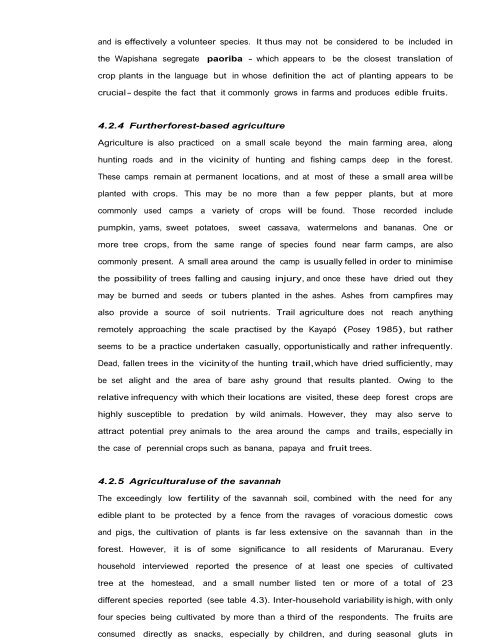Ethnoecology, Resource Use, Conservation And Development In A ...
Ethnoecology, Resource Use, Conservation And Development In A ...
Ethnoecology, Resource Use, Conservation And Development In A ...
You also want an ePaper? Increase the reach of your titles
YUMPU automatically turns print PDFs into web optimized ePapers that Google loves.
and is effectively a volunteer species. It thus may not be considered to be included in<br />
the Wapishana segregate paoriba - which appears to be the closest translation of<br />
crop plants in the language but in whose definition the act of planting appears to be<br />
crucial - despite the fact that it commonly grows in farms and produces edible fruits.<br />
4.2.4 Further forest-based agriculture<br />
Agriculture is also practiced on a small scale beyond the main farming area, along<br />
hunting roads and in the vicinity of hunting and fishing camps deep in the forest.<br />
These camps remain at permanent locations, and at most of these a small area will be<br />
planted with crops. This may be no more than a few pepper plants, but at more<br />
commonly used camps a variety of crops will be found. Those recorded include<br />
pumpkin, yams, sweet potatoes, sweet cassava, watermelons and bananas. One or<br />
more tree crops, from the same range of species found near farm camps, are also<br />
commonly present. A small area around the camp is usually felled in order to minimise<br />
the possibility of trees falling and causing injury, and once these have dried out they<br />
may be burned and seeds or tubers planted in the ashes. Ashes from campfires may<br />
also provide a source of soil nutrients. Trail agriculture does not reach anything<br />
remotely approaching the scale practised by the Kayapó (Posey 1985), but rather<br />
seems to be a practice undertaken casually, opportunistically and rather infrequently.<br />
Dead, fallen trees in the vicinity of the hunting trail, which have dried sufficiently, may<br />
be set alight and the area of bare ashy ground that results planted. Owing to the<br />
relative infrequency with which their locations are visited, these deep forest crops are<br />
highly susceptible to predation by wild animals. However, they may also serve to<br />
attract potential prey animals to the area around the camps and trails, especially in<br />
the case of perennial crops such as banana, papaya and fruit trees.<br />
4.2.5 Agricultural use of the savannah<br />
The exceedingly low fertility of the savannah soil, combined with the need for any<br />
edible plant to be protected by a fence from the ravages of voracious domestic cows<br />
and pigs, the cultivation of plants is far less extensive on the savannah than in the<br />
forest. However, it is of some significance to all residents of Maruranau. Every<br />
household interviewed reported the presence of at least one species of cultivated<br />
tree at the homestead, and a small number listed ten or more of a total of 23<br />
different species reported (see table 4.3). <strong>In</strong>ter-household variability is high, with only<br />
four species being cultivated by more than a third of the respondents. The fruits are<br />
consumed directly as snacks, especially by children, and during seasonal gluts in


